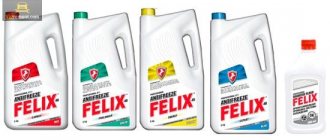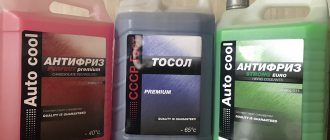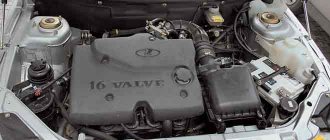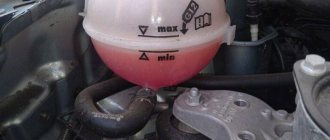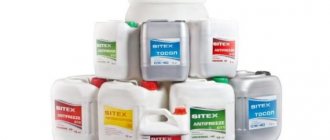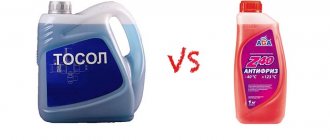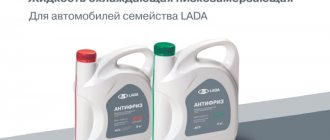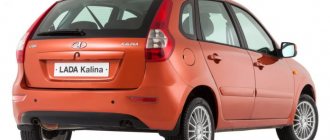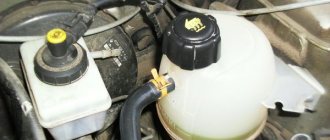Before pouring liquid into the cooling system, every driver will definitely be puzzled by the brand of this very liquid. And 90% of the public will think about what is better for our VAZ-2110 - antifreeze or antifreeze. The absurdity of this question lies in the fact that Antifreeze is antifreeze, that is, a liquid that does not freeze in the cold. Discrepancies arose in the late 80s and were so deeply absorbed into automotive culture that it is difficult to eradicate them. But we will try to do it right now.
What are coolants?
“Anti-freeze” is necessary for effective engine cooling. They must have the highest boiling point, since in the summer the engine often overheats. In addition, in most of our country, in winter the temperature drops to critical levels; in order for the cooling system to function normally, you need to take liquid with a freezing threshold at the lowest possible temperatures, this is especially important in Siberia and the northern territories.
Antifreeze and antifreeze have the same base - ethylene glycol mixed with distilled water. In its natural form, this alcohol boils at a temperature of 196 degrees and freezes at -11. When mixed with distilled water, you can increase the freezing threshold to -35, or even -65. This is enough to use liquids in the cooling system throughout Russia.
To increase the effectiveness of anti-freeze agents, additives are added to them, which perform another important function - they help protect pipes, tubes, radiator and engine block from the aggressive effects of liquid. If you pour a composition of two components (ethylene glycol and distilled water) into the system, then in the next month you will have to change the entire cooling system and even repair the engine. Thanks to additives, which occupy up to 20% of the volume of any antifreeze, the composition becomes more perfect.
Antifreeze
This blue liquid is known to all Soviet car enthusiasts. It is most often used on domestic cars and is nothing more than antifreeze, which uses traditional additives. Everyone thinks that this liquid comes in only one color, but there are two options for antifreeze:
- blue with a freezing threshold of about -30;
- red (pink) with operating temperature up to -50.
Chemical additives help the fluid form thin films on surfaces. With whom she comes into contact.
The advantages of antifreeze include its low price and popularity on domestic cars (many units work with it without failures, including the VAZ-2110).
At the same time, the classic “anti-freeze” has several disadvantages:
- impossibility of use on high-temperature engines (boils at 110 degrees);
- the need to change antifreeze after two to three years;
- high activity of the composition.
Domestic cars for the most part work properly on it, but foreign cars (especially new ones with composition sensors) may not even start if you put traditional antifreeze in the tank.
G11 – green antifreeze
At the beginning, it is worth noting that not only green-colored liquids are produced with the “G11” marking, they can be painted blue or even yellow, but recently manufacturers most often produce antifreeze of a grassy color. It copes well with small pockets of corrosion, which are neutralized with the help of additives.
In terms of its properties, G11 can be equated to antifreeze. It has one more small drawback - over time, the deposited additives begin to crumble and clog the small channels of the cooling system. The film that forms on the walls of the components reduces the heat removal from the engine, which has a more detrimental effect on it.
G12 – red antifreeze
This “anti-freeze” product uses fewer chemical additives; when modernizing the composition, manufacturers replaced them with organic ones (mainly carboxylic acid). Their main advantage is that a protective film is not formed and, accordingly, heat removal is not impaired. This antifreeze has improved characteristics:
- heat is removed more efficiently;
- there are no deposits on the walls of the system, therefore nothing crumbles;
- long service life - up to 60 months;
- The liquid fights corrosion areas.
With all these advantages, the G12 has one significant drawback - during its use, automatic maintenance of the cooling system is not carried out. This antifreeze best protects systems in which parts are made of brass and copper, but it does not have a pronounced positive effect on aluminum.
G13 – purple antifreeze
In 2012, the newest antifreeze composition appeared on the markets - G13, which is colored purple in most cases. The base used for it is propylene glycol, an alcohol that is less toxic and active. The formula of this antifreeze is designed specifically to reduce the negative impact on the environment. At the same time, the additive complex was left unchanged - these are carboxylic acid and silicate compounds.
Many of the foreign cars of recent years operate only on this composition, since their system has a special sensor installed that measures the density of the “anti-freeze” and determines its composition. The VAZ-2110 does not have such a unit, so you can also use G13 in it, if you don’t mind paying the maximum price for it (antifreeze and other antifreezes are much cheaper).
Stories from our readers
“Fucking basin. "
Hi all! My name is Mikhail, now I’ll tell you a story about how I managed to exchange my two-wheeler for a 2010 Camry. It all started with the fact that I began to be wildly irritated by the breakdowns of the two-wheeler, it seemed like nothing serious was broken, but damn it, there were so many little things that really started to irritate me. This is where the idea arose that it was time to change the car to a foreign car. The choice fell on the melting Camry of the tenth years.
Yes, I had matured morally, but financially I just couldn’t handle it. I’ll say right away that I am against loans and taking a car, especially not a new one, on credit is unreasonable. My salary is 24k a month, so collecting 600-700 thousand is almost impossible for me. I started looking for different ways to make money on the Internet. You can’t imagine how many scams there are, what I haven’t tried: sports betting, network marketing, and even the volcano casino, where I successfully lost about 10 thousand ((The only direction in which it seemed to me that I could make money was currency trading on the stock exchange, they call it Forex. But when I started delving into it, I realized that it was very difficult for me. I continued to dig further and came across binary options. The essence is the same as in Forex, but it’s much easier to understand. I started reading forums, studying trading strategies. I tried it on a demo account, then opened a real account. To be honest, I didn’t manage to start earning money right away, until I understood all the mechanics of options, I lost about 3,000 rubles, but as it turned out, it was a precious experience. Now I earn 5-7 thousand rubles a day. I managed to get the car buy after half a year, but in my opinion this is a good result, and it’s not about the car, my life has changed, I naturally quit my job, I have more free time for myself and my family. You’ll laugh, but I work directly on the phone)) If If you want to change your life like me, then here’s what I advise you to do right now: 1. Register on the site 2. Practice on a Demo account (it’s free). 3. As soon as you get something on the Demo account, top up your REAL ACCOUNT and go to REAL MONEY! I also advise you to download the application to your phone, it’s much more convenient to work from your phone. Download here.
Antifreeze is also antifreeze, which in 99% of cases consists of ethylene glycol. The name “TOSOL” was assigned to one brand of antifreeze back in the USSR, and so it became boring. That is, antifreeze is Russian antifreeze. Antifreeze, unlike antifreeze, can be diluted or a concentrate, which must be diluted before pouring into the car.
How to choose high-quality coolant? Whether antifreeze is good or not is determined by its quality and set of additives. All properties of antifreeze depend on the set of additives. To avoid buying a fake, antifreeze should be purchased in reliable stores from good and well-known manufacturers. You can choose a brand based on a review of coolants, survey results or comments.
What color antifreeze should I buy? You can mix different colors of coolant. More details about this in this article.
How long does it take to change the coolant in a VAZ 2110? According to the regulations, it is changed after 5 years or 70 thousand km. mileage, in practice it all depends on the operating conditions and the quality of the antifreeze.
How to replace antifreeze in a VAZ 2110? Change the coolant according to these instructions.
So, let’s vote and leave reviews about antifreeze for VAZ 2110-12 :
- What brand of antifreeze/antifreeze did you choose?
- What do you fill with antifreeze or antifreeze?
- How often do you change the coolant?
- Impressions and comments on antifreeze/antifreeze?
ps Off-topic comments will be deleted.
Which coolant is better to choose for the VAZ 2110-12?
How long does it take to replace antifreeze/antifreeze in a VAZ 2110-12?
What to choose, antifreeze or antifreeze for VAZ 2110-12?
Before pouring liquid into the cooling system, every driver will definitely be puzzled by the brand of this very liquid. And 90% of the public will think about what is better for our VAZ-2110 - antifreeze or antifreeze. The absurdity of this question lies in the fact that Antifreeze is antifreeze, that is, a liquid that does not freeze in the cold. Discrepancies arose in the late 80s and were so deeply absorbed into automotive culture that it is difficult to eradicate them. But we will try to do it right now.
Causes of malfunctions
The fan may not turn on for the following reasons:
- the fan drive (electric motor) is faulty;
- fuse is blown;
- the relay has failed;
- broken electrical wiring;
- lack of contact in the temperature sensor connector;
- The temperature sensor is faulty.
Search for reasons
Diagnosis of a fan malfunction should begin with the fan itself. To do this, disconnect the connector on the fan and connect it, observing the polarity, directly to the battery terminals. If it turns on, it means the drive is working, the reason needs to be looked for further. If the fan does not work, this is the reason. But let's take things in order.
The fan did not turn on. We check the integrity of the wiring and the condition of the contacts on the sensor. If everything is in order, we move on to the fuse and fan relay. They are located under the hood on the left side closer to the driver, in the mounting block.
Fuse F4 is 20A, double, for the sound signal and the cooling fan (it is very easy to check; if there is no sound signal and the fan does not work, then most likely it is the culprit).
You can check the fuse with an ordinary autotester. With relays the situation is more complicated. To make sure that this is not the case, it is better to get a one hundred percent working relay somewhere and temporarily install it in the socket for testing. If the fan does not work even with it, we go to the sensor.
If the sensor is de-energized, the controller must start the fan in emergency mode for constant blowing. Disconnect the connector from it and turn on the ignition. Turning on the fan will indicate that the sensor has failed and requires replacement.
When is it necessary to change a fan?
If the cause is still in the fan itself, you can try to repair it. The problem is usually the brushes or bearings. But it also happens that the electric motor fails due to a short circuit or break in the windings. In such cases, it is better not to experiment and replace the entire drive.
It is strictly forbidden to operate a vehicle with a non-working cooling fan. Overheating of the coolant will inevitably lead to the destruction of rubber pipes and hoses, as well as cylinder head gaskets and valve covers. In addition, high engine temperature can cause destruction of the piston group elements.
How much does a cooling fan cost on a VAZ 2114
You can buy a new cooling fan for a VAZ 2114 for 1500-2500 rubles. Replacing this part at a service station will cost 300-400 rubles. But you don’t have to spend money on this. Dismantling the old fan and installing a new one at home will take no more than 30 minutes.
What is antifreeze and what does Antifreeze have to do with it?
As soon as the first cooling system appeared, it was filled with the most accessible and efficient coolant on the planet - water. The water was good for everyone, but had one drawback. At sub-zero temperatures, it froze and, expanding, tore apart ancient cylinder blocks, radiators and heads . Therefore, back in the late 20s, they began to add ethylene glycol to the water, which did not freeze, but turned into a plastic porridge in the cold. There is little good in this, but there is no particular problem either - old cast-iron engines did not suffer from freezing.
They called this thing antifreeze, an antifreeze liquid.
Antifreeze or antifreeze, which is better?
Everything would be fine, but in the early 60s, engines with aluminum blocks and parts made of complex alloys began to appear. It was on these parts and on aluminum that ethylene glycol had a fatal effect - corrosion devoured not only new cylinder blocks, but also pump impellers, copper and brass elements of the cooling system. In the USSR they were not particularly worried about this, since all the cars had cast iron blocks and were not afraid of corrosion.
But then a problem suddenly appeared. During tests of the Fiat 124, the future VAZ 2101, it turned out that in the USSR there was no antifreeze suitable for the Italian engine. The Italians offered their liquid, but the union resolutely refused. In order to save scarce currency, the GosNIIOKhT Institute was instructed to quickly develop such a liquid for Zhiguli cars in order to overcome corrosion and establish production in the required volumes. Without thinking for long, the scientists added special additives to the mixture of ethylene glycol and water, which created a protective layer on the walls of the water jacket and did their best to protect the engine from corrosion.
Antifreeze was developed in the USSR specifically for the Zhiguli car.
The composition was called Antifreeze because it was developed in the Department of Organic Synthesis Technologies, and the prefix “ol” is part of the chemical name of the substance.
one conclusion from here - Antifreeze is an antifreeze that was developed in the USSR in the 60s specifically for VAZ and over time its name became a household name.
Video which is better, antifreeze or antifreeze
Characteristics
Sometimes you can find disputes about what is better - antifreeze or antifreeze? If you understand the intricacies, then antifreeze is actually antifreeze, but a special one, developed back in the years of socialism. It is superior to known types of coolants in many respects, and it cannot be compared with water at all, although many still do not understand this.
So, what are the most significant advantages of antifreeze:
- When heated, antifreeze has significantly less expansion than water. This means that even if there is a small gap, there will be enough space for it to expand, and it will not rupture the system or tear out the cover or pipes;
- It, compared to ordinary water, boils at a higher temperature;
- Antifreeze flows even at temperatures below zero, and at very low temperatures it turns not into ice, but into a gel; again, it does not break the system, but simply freezes slightly;
- It doesn't foam;
- It does not promote corrosion like water, but, on the contrary, protects the engine from it.
What is the difference between Antifreeze and other antifreezes, classification
Antifreeze is a first generation antifreeze with a minimum of additives and it differs from modern compounds, like Zhiguli from Tesla. Antifreeze is a cheap and low-quality antifreeze without lubricating, antifoaming, cleaning and other additives that are found in any other antifreeze. Most often, Antifreeze is blue-tinted water with a minimal amount of ethylene glycol, and its use on modern cars cannot be justified even by its meager price and availability on any car market in any quantity. Most often, even sellers have no idea about the composition of Antifreeze; the liquid can be made on the basis of any antifreeze (carboxylate, silicate), which the label does not even mention.
Antifreeze, unlike antifreeze, contains various additives.
Modern antifreezes differ from each other only in composition and not in color.
Color is not an additive, it is just a dye and has nothing to do with the composition of the liquid.
Now briefly about the classification of modern antifreezes.
Antifreeze G11
G11 - green antifreeze.
If we get our hands on a canister marked G11 , we can be sure that it is antifreeze based on silicates and with a small amount of inorganic additives. In other words, this is an analogue of that very ancient Antifreeze. The main disadvantage of such antifreezes is the protective film that they create over the entire area of the cooling system. Over time, the film reduces the heat transfer of the engine, and it may cool worse. Such compositions boil already at 105 degrees, and they need to be replaced every 1.5–2 years . As a rule, they are used in large-volume engines on cars produced before 94-95. Inexpensive, it can last 40-50 thousand kilometers tolerably, but it needs to be replaced as often as possible.
Antifreeze G12 and G12+
G12 - red antifreeze.
The next generation of carboxylate-based antifreezes. The principle of operation of the composition is radically different from G11 . It does not create films, does not clog the system, and removes pockets of corrosion thanks to additives. They have a full range of anti-foam, lubricating and cleaning additives, excellent thermal conductivity and a five-year service life. The same can be said about G12+ antifreeze , this is a more advanced version of carboxylate compounds.
Antifreeze G13
G13 - purple antifreeze.
One of the latest generations of propylene glycol-based compounds. It has excellent thermal conductivity, long service life and low toxicity . Used in highly loaded forced modern engines. The composition includes the most modern additives for caring for the cooling system.
More about markings
Class G11
Antifreezes marked G11 are antifreezes based on silicates and inorganic additives. Used for cars up to 1996. And now the main thing is that Antifreeze has the same composition! Therefore, remember, coolants Antifreeze and Antifreeze brand G11 are the ONE AND THE SAME!
G11 antifreeze (Tosol) is designed for older cars with a large cooling system. They create a protective film throughout the cooling system that protects parts from corrosion, but this protection has a drawback - this protective film reduces thermal conductivity. Therefore, in a modern car with thin cooling system channels, G11 is not suitable, because engine cooling deteriorates. In addition, the boiling point of G11 antifreeze is 105 degrees. The maximum service life of such coolants is 2-3 years or up to 50-80 thousand km. mileage
Class G12
G12 antifreezes have a completely different composition of additives than G11 (Antifreeze) - these are carboxylate organic compounds. Used on high-speed, heat-loaded vehicles. Boiling point is 115-120 degrees. G12 does not create a protective film throughout the entire system, but only acts on areas of possible corrosion. Therefore, the thermal conductivity of G12 antifreeze is higher than that of G11. The service life of the G12 is 5 years or 250 thousand km. mileage
Class G12+
G12+ antifreeze is slightly different from G12, the same carboxylate organic antifreeze. We can say that this is the next generation after the G12, used on modern cars. The operating method and service life are similar to G12.
Class G13
G13 antifreeze is the newest generation of coolant; it is no longer based on ethylene glycol like G11, G12, G12+, but on propylene glycol. This antifreeze is less toxic and decomposes faster, i.e. causes less harm to the environment during disposal or leakage, but is also more expensive. Used for high-performance engines. Engines of sports cars, motorcycles, etc. for engines operating in extreme conditions. They say they don’t make it in the CIS countries yet (at the time of writing this article (2014)) due to its high cost, but I’ve already seen it on sale, although I didn’t pay attention to the manufacturer.
What's the result?
As you can see, for VAZ-2110 engines you can theoretically use any type of antifreeze. The plant recommends using G11 antifreeze for cars manufactured before 1999; all other cars can be safely filled with G12 and G12+ . We choose the manufacturer at our discretion; mixing antifreezes of different groups is strictly not recommended. Otherwise, you can end up with a clogged cooling system, an overheated engine, and fork out for expensive repairs. Good luck with your choice and good travels!
According to the maintenance regulations for Lada cars, the coolant (antifreeze, antifreeze) should be changed every 75 thousand km. mileage or after 5 years, whichever comes first. At this moment, it is important to choose the right liquid correctly, then there will be no comments about it for the same amount of time.
What are the dangers of air jams?
Often, inexperienced owners “boil” the engine, and the engine overheats. This usually happens when the car is moving in low gear, when the VAZ 2110 16 valve coolant sensor does not operate and the electric cooling fan does not turn on. An experienced driver monitors the readings on the instrument panel while driving and can promptly notice that the antifreeze temperature needle has entered the red zone. What signals the approach of overheating, which means it is important to take emergency measures:
- You need to immediately (regardless of the season of the year) turn on the “stove”
- When the heater fan blows hot air, this means the fan is broken.
- When it blows cold, the cause of overheating lies in the airlock that has arisen.
- In the first situation, it is prohibited to turn off the engine until, thanks to the running “stove,” the engine temperature drops
- In the second situation, you can turn off the engine, then, after waiting for the engine to cool, remove the expansion tank cap
- Then unscrew the hose as described above and add antifreeze, allowing air to escape
That's all with replacement, the video lesson will help you if you don't understand something. Good luck with the renovation.
What antifreeze does AvtoVAZ recommend?
For all VAZ engines (Lada Granta, Kalina, Priora, Niva 4x4), the manufacturer’s recommendations are the same (data from books on the operation, maintenance and repair of Lada cars):
- Antifreeze G-48;
- Cool Steam Standard;
- Cool Steam Premium;
- TS-Felix;
- Felix Carbox;
- SINTEC (for example, “Antifreeze SINTEC” TU 2422-047-51140047-200). This red G-12 antifreeze is poured into the Vesta engine from the factory.
- Long Life;
- G-Energy Antefreexe.
For K4M and K7M power units that are installed on Lada Largus, the manufacturer recommends GLACOEL RX antifreeze (type D). For Lada Vesta and XRAY, it is recommended to use Type D antifreeze based on a mixture of water and ethylene glycol.
AvtoVAZ's response
: coolant in the VAZ 21179 engine cooling system - Antifreeze Sintec LUX G12 (Sintec ANTIFREEZLUX G12).
Coolstream NRC in yellow is also used.
Is it possible to mix antifreeze?
Is it possible to mix antifreeze from different manufacturers? The operating manual for the Lada car states: “The use of mixtures of coolants of different brands is not allowed.”
Is it possible to mix antifreeze of different colors, but from the same manufacturer? There is no definite answer, because... Some manufacturers color the coolant “to taste,” while others add color based on the chemical composition or additives. According to statistics, about 85% of motorists do not mix antifreeze of different colors. At the same time, 64% believe that if you mix antifreeze of different colors, nothing bad will happen. You can view the survey and take part in it here.
The book on operation, maintenance and repair of the Lada Vesta car states:
Which company is better
“Behind the Wheel” tested coolants in November 2022. Test results:
In the survey below we provide recommendations for choosing a coolant manufacturer. We share tips in the comments. Let us remind you that the process of replacing antifreeze on Lada cars is described in this article.
VAZ 2110 car of domestic production. Popularly known as “ten”. It is a representative of a small class car. It was produced for 12 years from 1997 to 2007. Despite this, it continues to be popular among Russian drivers.
The car is equipped with several types of engines, of different sizes from 1.5 to 1.6 liters. Models produced before 2000 were equipped with a carburetor, subsequent ones with an injection system. The main advantages are high ground clearance and indestructible suspension.
Optimal coolant option
When you have figured out how to replace antifreeze on a VAZ 2110 (2112), it is important to choose the optimal fluid option. Many car enthusiasts only use expensive antifreeze, considering it to be of higher quality. For VAZ cars, it is quite possible to use a cheap domestic product - antifreeze, the characteristics of which were developed specifically for these cars.
Owners of domestic cars respond positively to Felix brand antifreeze. It is sold in canisters of 5 and 10 liters, and smaller containers. It is profitable to purchase liquid in a 10 kg container - it is cheaper, and after replacing the used antifreeze, there is still liquid left for refilling.
Didn't find the information you are looking for? on our forum.
Filling volumes and brands of oils and liquids Lada VAZ 2110
Filling/lubrication point
Name of oil/liquid
What and how much to fill in LADA (VAZ) 2110
Fuel tank – 43 l. Fuel type: gasoline AI-92, AI-95.
The engine oil should be changed every 10 thousand km. At the same time, a new oil filter is installed. Recommended liquid with API quality level: SG, SH, SJ. Refill volume – 3.5 l. It is also used for the crankcase of the power plant.
Antifreeze must be changed every 60 thousand km or once every two years. The following coolants are recommended: Tosol AM, Tosol A-40M, OZH-K-HT, OZH-40-HT, OZH-K-SK, OZH-40-SK, OZH-40, TOSOL-TS, AGIP ANTIFREEZE EXTRA, Glisantin G 03.
The car's operating instructions indicate the frequency of changing transmission oil - 30 thousand km. It is necessary to select fluids based on operating conditions:
- from –26°С to +45°С SAE 80W-85 (API GL-4, GL-4/5);
- from –40°С to +45°С SAE 75W-90 (GL-4/5).
The lubrication of the rear axle housing is changed every 60 thousand km. At the same time, its level is periodically monitored. It needs to be checked every 20 thousand km. If necessary, top up to the mark.
Brake fluid should be replaced once every two years regardless of the vehicle's mileage. Domestic DOT-4 or a foreign equivalent is recommended. Volume – 0.55 l.
Lada VAZ-2110 (2111, 2112). CHECKING COOLANT LEVEL AND ADDING COOLANT
The manufacturer recommends using original coolant.
Do not mix liquids of different colors and different manufacturers. If you need to add coolant, but you do not know the brand of coolant in the system, replace all coolant in the cooling system. Use products only from trusted manufacturers. Remember that using low-quality coolant leads to expensive engine repairs! Before starting work, place the vehicle on a level surface.
Check the coolant level only when the engine is cold. Coolant is toxic, so take precautions when working with it.
Do not pour fluid into the reservoir above the “MAX” mark, as its volume will increase when the engine is running.
When starting the engine, the expansion tank and radiator caps must be closed.
Constantly monitor the coolant level. Its sharp decrease or increase should be a signal for an immediate check of the engine cooling system. If freshly poured antifreeze suddenly unexpectedly quickly changes color to brown, it means that you were sold a fake, in which they “forgot” to add corrosion inhibitors. Replace the fluid as quickly as possible before it has time to corrode the cooling system elements.
1. Check the coolant level. It should be between the “MAX” and “MI N” marks marked on the wall of the expansion tank.
2. To add fluid, unscrew the cap of the expansion tank.
. and add coolant to the “MAX” mark.
4. Close the expansion tank cap.
If the expansion tank is completely empty, press the filler cap of the radiator of the engine cooling system and turn it counterclockwise.
. and remove the plug
Add coolant to the edge of the filler neck. Then close the neck with a stopper.
Add coolant to the expansion tank to the required level (see above).
Screw the filler cap of the radiator of the engine cooling system tightly. When the engine is running, the cooling system is under pressure, so coolant may leak from under a loose plug or the plug may break off.
There are two valves installed in the radiator cap: intake A and exhaust B. The exhaust valve plays a big role in ensuring optimal engine temperature conditions. It maintains an excess pressure in the system of at least 0.08-0.10 MPa (0.8-1.0 kgf/cm2), ensuring an increase in the temperature at which the coolant begins to boil and preventing intense vaporization.
When the valve jams in the closed position due to overheating, a significant excess of excess pressure occurs - more than 0.2 MPa (2 kgf/cm 2), which can lead to damage to the radiator or failure of one of the hoses. In turn, jamming of the valve in the open position leads to premature boiling of the coolant.
Therefore, wash the radiator cap with running water once a year. If in doubt, replace the plug. Obviously, if you remove the radiator cap on an overheated engine and this action coincides with thermal shock, then boiling of the liquid and the formation of air pockets in the cooling system will be guaranteed.
The cooling system of the VAZ 2110 is an important component on which the operation of the entire car depends, because overheating of the engine and its parts can cause serious damage. Many domestic and foreign cars have a closed-type liquid cooling system, the main component of which is antifreeze (coolant).
Reasons for replacement
If we talk about the service life of antifreeze on a VAZ 2110, then it is within 150 thousand kilometers, and it is advisable not to exceed this mileage. Although in practice it happens that replacement or the need to partially change the coolant arises long before the speedometer shows so many kilometers.
- Have you noticed that the color of the antifreeze in the expansion tank has changed and has become rusty;
- You notice an oil film on the surface of the tank;
- Your VAZ 2110 often boils, although there are no special prerequisites for this. You need to remember that the VAZ 2110 is still a fast car, and it doesn’t like driving very slowly; it sometimes causes the coolant to boil. This may be due to the cooling fan not running at low speed. It is also possible that unusable antifreeze is boiling and needs replacement;
- The coolant is going somewhere. This is a fairly common problem with the VAZ 2110, and simply replacing it or replenishing the level will not help, you need to look for where the antifreeze is leaking. Sometimes the liquid leaves so unnoticed, especially if the temperature reaches the point where it boils and evaporates in ways unknown to the driver, leaving no visible traces. As practice shows, most often the cause should be sought in the clamps. Sometimes replacing them completely helps. To find out for sure that the fluid is leaving, you need to check the level on a cold engine. If the engine is not even boiling, but is fairly hot, if there is a slight leak somewhere, you may not notice it - heated antifreeze may show a normal level, although this is not the case;
- The coolant level is normal, that is, at the level of the upper edge of the belt securing the reservoir, the color has not changed, but the antifreeze boils quickly. It is possible that there is an air lock. By the way, when heating and cooling the level changes somewhat. But if, during constant checks on a cooled VAZ 2110, you notice that the antifreeze is leaving, you should find where, otherwise replacing it will not yield anything.
Design and functions of the cooling system
The operation of the VAZ 2110 cooling system is aimed not only at cooling parts and the engine, but also at performing other functions, and, more precisely, at:
- heating the air in the cabin;
- lubricant cooling;
- cooling of working elements in the automatic transmission system;
- cooling the air in the turbocharger.
The cooling system diagram of the VAZ 2110 is quite simple if you look into it carefully. It is represented by the following elements:
- Cooling radiator, responsible for cooling heated antifreeze;
- A fan that enhances the cooling of antifreeze in the radiator;
- Heater radiator, responsible for heating the interior;
- An expansion tank into which coolant flows after strong heating;
- A pump that ensures continuous circulation of liquid;
- Thermostat regulating the circulation of antifreeze;
- Temperature sensor;
- The pipes through which the liquid moves, and the fixing clamps.
In the entire system, as in the whole car, it is difficult to identify important details, because its operation depends on the combined actions of all components. Of course, the hoses of the VAZ 2110 cooling system are secondary elements, but the circulation of antifreeze depends on them. All components must be firmly connected with clamps and treated with sealant. The cooling system pipe of the VAZ 2110 must be sealed, otherwise even a small crack can lead to a malfunction of the machine, a coolant leak and subsequent more serious damage.
The VAZ 2110 cooling system heater is the most amazing component, designed not to cool, but to warm the air in the cabin. Its presence implements the main technical task of any device - to make maximum use of available resources to perform basic and related tasks.
Coolant filling procedure
It’s worth checking first how much antifreeze is needed in a VAZ 2110 for 16 antifreeze valves. After this, you can begin work.
- The coolant drain hose is removed from the throttle valve. To do this, you first need to loosen the clamp holding it. The hose should not be thrown on the ground; it must be suspended from something nearby.
- The liquid must be poured slowly and observed whether it flows from any hose. If there is a leak, quickly put the hose back in place. After this, add antifreeze to the required level and close the plug.
After filling the cooler, it is important to observe the operation of the engine for a while. If it gets very hot, and cold air comes out of the switched on stove, then an air lock has formed in the system, which must be removed.
The principle of operation of the cooling system
As soon as you start the engine, the cooling system starts working. Of course, when starting, the main task is to heat the air in the cabin and achieve the operating temperature of the engine parts (approximately 90 degrees). However, the circulation of the cooling system of the VAZ 2110 is forced, that is, it is constant and is ensured by the operation of the pump, so it is impossible to influence its on/off.
The system is represented by small and large circles, in which liquid circulates depending on the temperature of the working parts and the engine. At the beginning of operation, the antifreeze moves in a small circle, which does not include the cooling radiator. As soon as the liquid reaches a temperature of 85-90 degrees, the main thermostat valve opens and antifreeze enters a large circle that connects the cooling radiator.
If the air flow passing through the radiator grille is strong, then the liquid is cooled well, but if you move slowly, the antifreeze cools slowly and the temperature gradually rises, then the temperature sensor is triggered and the fan turns on, which helps cool the liquid.
Antifreeze and its main characteristics
The operation of the cooling system directly depends on the coolant (antifreeze). This occurs due to certain characteristics of antifreeze, including:
- Slight expansion when heated;
- High boiling point and low freezing point;
- Protective properties that protect parts from corrosion and oxidation;
- Performing lubrication of the part in parallel with the implementation of the main function.
In addition, antifreeze does not crystallize and when frozen it becomes like a gel.
It is not recommended to fill the cooling system with ordinary water, since it not only does not have the listed qualities, but also forms scale on the system elements, which leads to a decrease in service life and various malfunctions.
It is important to buy antifreeze from reliable and trusted manufacturers. Do not fill in liquids of different colors and brands, because the composition of antifreeze may differ between companies, and mixing components can lead to an unpleasant result.
Note to car owners
Please know that if you do not replace the antifreeze in a timely manner, then premature corrosion begins in the channels of the engine block and its head and, as a result, the engine life is significantly reduced:
- This affects the cylinder head the most.
- Working as a car mechanic, I often had to disassemble engines and observe the head cooling channels eaten away by corrosion
- After such a spectacle, anyone will feel scared for their car; you will certainly forget to change the antifreeze in a timely manner.
- At each scheduled maintenance, you need to check the level and appearance of antifreeze (more often if possible)
Important: The antifreeze level must be checked on a cooled engine; the permissible level is within (between) the lower and upper marks on the body of your expansion tank. A slight increase or decrease in this level that occurs when it is cooled or heated is not considered a malfunction; this is absolutely normal. Such level fluctuations are associated with thermal changes in volume (for example, expansion when heated and subsequent decrease in volume when cooled). However, if you notice a gradual decrease in the level with each new check on a cold engine, then you need to look for where the leak is occurring.
